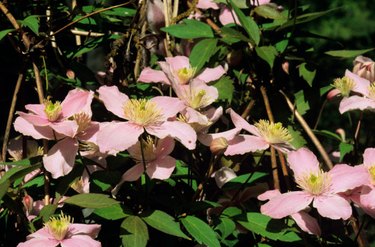
Clematis plants (Clematis, USDA plant hardiness zones 4 to 9) are prolific bloomers with an impressive variety of foliage and flowers. There are more than 200 clematis varieties in three categories: spring bloomers, large-flowered hybrids and late-flowering species that produce flowers in the summer.
Clematis Growth Rate
Video of the Day
Clematis plants can quickly grow very large once they are established. Naturally, each species grows at its own speed, and some can grow a few feet in a year, while others grow up to 20 feet. They are considered to be fence-climbing plants, so most of them come with small trellises when you buy them.
Video of the Day
The clematis vines outgrow these small trellises quickly, so it is wise to know how large the plant will get and plan accordingly. Since it is a climber, it can be planted by a large fence or a trellis. In an ideal world, you should use one that is about 57 to 75 inches high. It's worth the investment in a larger trellis since these beautiful plants can live up to 50 years.
Specific Variety Matters
The specific size of your clematis will vary based on the variety you choose. The smaller, herbaceous species of clematis top off at 5 feet, while the majority of the large-flowered hybrids can grow to be 30 feet tall.
Note that it takes a while for the roots to develop. Rather than growing very quickly at once, clematis growth rate starts off slow in the first year and gradually increases after that. Some experts whimsically describe the process as starting slow, then a creeping growth and finally a leaping growth.
Other Fence-Climbing Plants
The versatile, easy-growing clematis tops many lists of fence- and wall-climbing plants, but there are plenty more as well. There are many popular climber plants, including climbing roses (Rosa, USDA plant hardiness zones 5 to 10). As is the case with clematis, it is important to install supports before planting climbing roses. The latter has a long, structural cane that sends out smaller shoots that eventually spread out and produce flowers.
Wisteria (Wisteria sinensis, USDA plant hardiness zones 5 to 8) is another hardy climber that can grow to 30 inches high. It also has cascading, fragrant lilac and blue flowers that are beautiful to behold. These vines are a bit more aggressive, so keep an eye on them and do not plant them too close to your house. Also, note that Japanese and Chinese wisterias are considered to be invasive in some areas, so opt for Kentucky or American species instead.
Native to Japan and China, star jasmine (Trachelospermum jasminoides, USDA plant hardiness zones 8 to 10) features small, fragrant, star-shaped flowers. It can stretch up to 30 feet tall with support but can also be used as a ground cover. If red is your color, you can consider trumpet vines (Campsis radicans, USDA plant hardiness zones 4 to 9), which also grow fast and adapt to different growing conditions. Hummingbirds love trumpet vine flowers. The plants can grow up to 40 feet and can become invasive when not controlled.